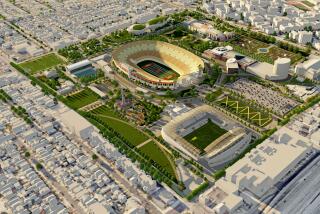American no-show would be bitter Shanghai surprise
- Share via
SHANGHAI — With the Beijing Olympics over, China is counting down to its next big coming-out party: the Expo 2010 World’s Fair in Shanghai.
But will the U.S. show up?
With construction deadlines approaching, organizers of the American exhibit are scrambling to come up with tens of millions of dollars from corporate sponsors for a national pavilion. The recession has only added to longer-running problems that could end up with the U.S. missing the Shanghai expo and, in the view of many, hurting bilateral relations and American commercial interests in the world’s third-largest economy.
“I think it’d be tragic if the U.S. isn’t represented in this expo,” said Nick Winslow, a Pasadena theme park expert who, with Beijing lawyer Ellen Eliasoph, was selected by the State Department to develop the U.S. pavilion and show. The pair, former colleagues at Warner Bros., say they have until April to raise as much as $84 million that was originally estimated for the project.
“It’s coming down to the wire,” Winslow said.
He and Eliasoph have talked with the Walt Disney Co., PepsiCo and some 120 other parties, as well as wealthy Chinese Americans, but there’s been no public commitment of funds except for $500,000 of seed money put up by Connecticut vitamin importer AnMar International.
Companies are hesitant to invest a lot for a building where their names and logos are to be presented subtly in the background rather than splashed out front.
What’s more, the expo lacks the international appeal of the Olympics, and its allure has faded, especially in the United States. The expo (or world’s fair) had its origins in mid-19th century Europe and for decades focused on trade, cultural exchanges and artistic and scientific innovations. In more recent years it has become more of a platform for so-called country branding, with national pavilions being the main attraction.
Winslow remembers going to his first world’s fair as a teenager in Seattle in 1962 and being captivated by the Space Needle and the monorail. In 2000, the U.S. skipped the expo in Hanover, Germany, drawing criticism from organizers but hardly a peep back home.
Yet many regard the Shanghai expo as far more important than those in the recent past, as it’s taking place in the commercial hub of the world’s most populous and arguably most important emerging economy. Some 70 million visitors are expected during the May-to-October exhibition, nearly triple the attendance at Hanover. About 185 countries will probably participate, and some already have broken ground on their national pavilions.
Leading the way is France, which is investing 50 million euros (about $66 million) in its building, perhaps the largest planned for the fair.
“This is sort of a very important thing to France,” said Franck Serrano, spokesman for the French company that’s handling the pavilion. “And also it is in China, the new giant. That’s why the scale of France’s exhibition is unprecedented this time.”
American officials are generally banned by law from using public money for an expo, so they have to rely on private sources. But bureaucratic missteps hurt the process: It wasn’t until last April that the State Department gave the go-ahead to Winslow and Eliasoph to design the pavilion, develop a show for it and raise funds. By October, their nonprofit venture ran out of money and word was out that they were shelving the deal. (It’s since been revived.) State Department representatives wouldn’t comment about the expo, except to say that the U.S. intended to participate.
“It’s a bizarre situation,” said Alex Xu, a Los Angeles developer of Greentree Inn hotels in China. “We can’t pay for a pavilion while we’re spending billions and billions on the war on terror.” Whatever Americans may know or feel about the expo, he added, “it’s a good opportunity to showcase the great side of the U.S. . . . for millions of people to see and experience who we are.”
Xu has a 178-room hotel in the Shanghai expo village but worries that even if the U.S. pavilion gets built, it won’t be up to par because of time and money constraints.
Local government officials are anxious too, and have suggested they could even help with some of the construction of the U.S. building. Last week the Shanghai expo’s deputy director, Hong Hao, told an American group that included potential sponsors that “especially when the U.S. pavilion project is faced with difficulty, we will remember any enterprise putting its shoulder to the wheel.”
Shanghai officials long ago set aside prime space for the U.S. pavilion at the fairgrounds, near the banks of the Huangpu River in Shanghai’s Pudong District.
The U.S. building would be about 60 feet high, encompassing 60,000 square feet, with wings on each side, representing a bald eagle, and a roof garden in the center. Burbank-based BRC Imagination Arts, a specialist in museum and exhibit designs, was brought in to create a high-tech, interactive show centering on sports heroes.
“It’s very Hollywood,” said Eliasoph, who headed Warner Bros.’ film efforts in China and now runs the Beijing office of the Washington law firm Covington & Burling.
Whether corporations will pony up is the big question. Two U.S. companies -- Coke and General Motors (with its Chinese partner, SAIC) -- are setting up their own pavilions at the expo, paying $50 million each to be corporate sponsors. McDonald’s and Starbucks, familiar brands throughout China, figure to have a strong presence in the expo village.
Observers speculate that Disney may become a major backer. The entertainment giant is planning to build a Disneyland in Shanghai, and getting behind the expo would likely give it some cachet in negotiations with officials in Shanghai and at the central government. A Disney spokeswoman declined to comment.
Although a no-show by the U.S. wouldn’t go down well in Beijing, it would really hurt America’s image among the Chinese public, said Sidney Rittenberg, a prominent China consultant based in Washington state.
“Most will feel it’s a deliberate humiliation,” he said. “It’s going to stir up a lot of bad feelings,” including the possibility of boycotts of American goods.
Eliasoph certainly hopes it won’t come down to that. By design, China’s pavilion was placed at one end of the fairgrounds and the U.S. pavilion at the other.
“It looks like America and China are co-anchoring the world,” she said. “It’s really striking if you imagine if we’re not there.”
--
More to Read
Sign up for Essential California
The most important California stories and recommendations in your inbox every morning.
You may occasionally receive promotional content from the Los Angeles Times.











